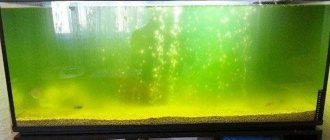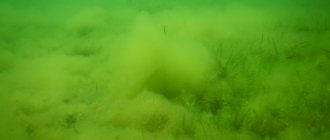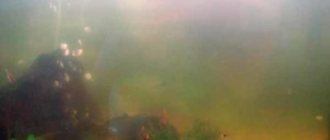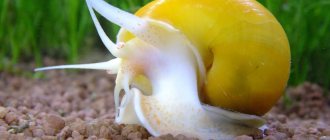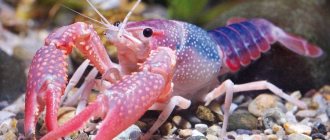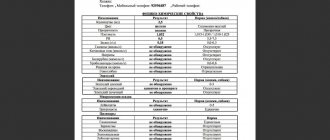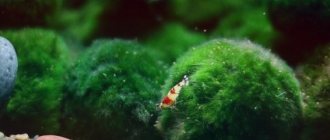An unpleasant brown coating, black threads on the glass, or green cloudiness of the water have appeared in your home underwater world, spoiling its appearance and your mood. Let's try to figure out what brown algae is in an aquarium and how to deal with it.
Inexperienced aquarists often confuse the algae themselves with underwater plants, which, on the contrary, are an absolutely organic attribute of any aquarium and are placed in it for a variety of purposes: as food for the inhabitants, as decoration, as a biological filter, shelter for fish, and also as substrate for their spawning. Diatoms have the unpleasant property of appearing on their own, clogging the filter, spoiling the appearance of the “fish house”, in a word, causing harm.
General characteristics of brown algae
If the water in the aquarium begins to become cloudy more often than usual, then this is a clear sign that an annoying pest has appeared in it - brown algae (diatom). Of course, aquarists independently decorate their “fish houses” with such useful underwater plants, but diatoms have an absolutely unflattering appearance and harm the aesthetic design. In addition to the fact that their appearance is accompanied by a deterioration in the appearance of the aquarium, they also cause a lot of trouble for aquatic inhabitants.
These plants are single-celled organisms that are characterized by a rapid reproduction rate. Diatoms have a silicon shell. They are also able to move quickly. In the natural ecosystem, brown algae play a very important role, since they make up a huge part of the plankton and are the main forming component of the organic matter of planet Earth.
However, in artificially created reservoirs this algae is an absolutely undesirable guest. Because of it, in places with an incorrect focus of light, a brown, slippery coating begins to appear, which gradually spreads over all surrounding surfaces.
The name “brown algae” does not hide the systematic affiliation of the species, but literally their color. This plant itself is a separate department of highly developed marine organisms with large thallus bodies. Most often, diatoms form in new aquariums, where their own ecosystem has not yet been established. And weak or improper lighting can be one of the reasons why these plants appear in artificial reservoirs that have been in operation for a long time.
Appearance
Diatoms are microscopic living organisms that can exist either individually or in colonies. This species is classified as a diatom, which means “divided in half.”
You can notice their presence on aquarium plants and surfaces by a brown, dusty coating. At the beginning of the development of infection, it is faintly visible, but as it develops it becomes increasingly saturated in color. The formation of algae begins in the most shaded areas of the “fish house”. The larger the scale of infection becomes, the more it complicates the existence of the inhabitants of your aquatic world.
Main representatives
Currently, science knows about 300 genera and 25 thousand species of diatoms. Representatives of the following genera usually live in home aquariums: Cymbella, Pinnilaria and Navicula.
Cymbella
These diatoms have a rich species composition. Their cells have the shapes of an oval, ellipse, sphere and spindle. These plants are either mobile or not. They are most often found in the summer. Cymbella is a favorite delicacy of insect larvae, which, in turn, are eaten by fish.
Pinnularia
Representatives of the Pinnularia species appear in aquariums in summer or early autumn. Science knows about 10 species of these plants. They reproduce by division within 4–6 days. The mother plant gives half of its shell to the daughter, the second part then grows back on its own.
Navicula
Navicula is the most numerous genus of diatoms. Its quantitative composition is approximately 10 thousand species. They are also quite varied in shape. Their diet is phototrophic. Navicula is very popular with young fish. In aquarium conditions they usually appear in spring and autumn.
Reproduction
These algae reproduce in two ways:
- vegetative;
- sexual.
The reproduction rate is quite high, usually representing a division in half. The pace directly depends on the environmental conditions. In one day, one cell can form about 35 billion new organisms. This type of algae inhabits almost any body of water in the world; they thrive in lakes, rivers, and seas with moderate water temperatures, although they are not afraid of hot springs and ice water. Diatoms, along with other similar microscopic plants, form the basis of the phytoplankton of the entire World Ocean.
They contain vitamins, fats and ash. Therefore, they serve as an excellent treat for small sea creatures that feed on fish.
One of the most important properties of diatoms is the production of oxygen.
Reasons for appearance
Absolutely all lovers of the home underwater world sooner or later face the issue of aquarium cleanliness.
Here are some of the main reasons for the destabilization of the biobalance and the appearance of brown algae:
- The light mode is incorrectly adjusted. In this situation, both the lack of lighting and its excess influence.
- Incorrect selection of aquarium inhabitants.
- Increased iodine content.
- Substrates that contain silicon, or sand at the bottom of the reservoir.
- Low water temperature, below 22 °C.
- pH level is above 7.5 mol/l.
- "Overpopulation".
- Increased level of silicates in the liquid.
- Excessive content of organic matter and nutrients due to systematic overfeeding of fish.
- Hasty application of fertilizers to a fresh reservoir;
- Untimely cleaning of the fish house and a clogged filter.
- Introducing diatoms when introducing new inhabitants from other aquariums.
What harm do they do?
Each type of aquarium pest causes its own particular harm to the habitat of underwater inhabitants.
Diatoms
These single-celled organisms have a durable shell consisting of silicon compounds. They do not pose any particular danger to the inhabitants of the home underwater world. Their harm is more of an aesthetic nature. Many fish, shrimp and even some types of snails will not mind eating them.
Euglena algae
They are called green turbidity and are compared to water blooms. Euglenaceae become dangerous for aquarium inhabitants at night. This is due to the fact that in the dark they actively consume oxygen and release carbon dioxide.
Green spot algae
They look like bright green dots on a variety of surfaces. They can be separate or merge into one continuous plaque. Over time, this algae forms a dense coating that is very difficult to remove.
Green filamentous algae
Long cobweb-like or short fleecy threads of bright green shades can fill the entire “fish house” in the shortest possible time.
Blue-green algae
During their life, these plants form a continuous coating of blue-green color, characterized by an extremely unpleasant odor. They release a toxin that is dangerous to animals into the water and contribute to the accumulation of high levels of nitrates in the water.
Red algae
“Black beard”, which looks like short and dense threads, “deer horn” - long branch-like formations and “flip-flop”. All of them use the stems and leaves of aquarium higher plants as their habitat. Algae begin to suffer from lack of nutrition and light, which can lead to the death of the entire plant.
Common types of diatoms
With the advent of powerful microscopes, the study of the underwater world intensified, and scientists were able to describe and identify the smallest species, which literally consist of one cell and a nucleus.
The most common types of brown algae are:
- Pinnularia, which has elliptical elongated valves with noticeable roughness of the shell.
- Cymbella. It is distinguished by its characteristic sickle-shaped valves.
- Navicula. It has sharp boat-shaped shell flaps with narrowed ends.
Naviculae are most often found in freshwater aquariums.
Colonies of naviculae are most often found in freshwater aquariums, characterized by a brown and brown color. Subsequently, actively growing, these algae acquire a characteristic black color. In saltwater aquariums, there can be dozens or hundreds of different diatoms that are gray, brown, black and purple.
Without exception, all aquarists have encountered the problem of diatoms, which form a characteristic brown coating on plant leaves, stones, decorations and glass. If at first it is not difficult to deal with such protozoa, and the aquarist can easily maintain the cleanliness of glasses, decorations and plants, then as the biobalance deteriorates, the colony of protozoa only grows. As a result, it becomes more and more difficult to get rid of black and brown plaque.
Signs of algae
In order to know how to resist this or that uninvited guest in an apartment pond, you need to know the main signs of their appearance.
Green algae
These plants are long green threads that begin to actively grow when exposed to plenty of natural sunlight. Such organisms pose a threat to all other plants due to the fact that they draw all the nutrients from them. Here are some tips that will help you figure out how to deal with green algae in an aquarium without much expense. This problem can be solved with the help of mechanical cleaning or by introducing special algae-eating fish. Frequent water changes are also good to combat them. Professionals recommend using an algaecide. If green dots appear on the walls of the aquarium, then this is also one of the varieties of green algae. You can fight them with the help of fish, snails that feed on these organisms, or ordinary scrapers.
Brown algae
In an aquarium, they take on the appearance of brown slime, which grows literally everywhere: on glass, on the ground, on decor, and even on underwater plants. For algae eaters, diatoms are one of the most favorite delicacies.
Blue-green algae
Blue-green algae in an aquarium is considered the most harmful. Their distinctive feature is the ability to produce toxic substances that are extremely harmful to underwater inhabitants. The growth of blue-green algae is positively affected by excessive lighting and increased levels of phosphates and nitrates. The fish prefer not to feed on these parasites. Therefore, the best method of combating algae in an aquarium is to completely turn off the lights and frequently change the water.
Ways to eliminate brown deposits
Various methods are used to combat brown plaque:
- Chemical - the use of algaecide preparations that suppress the growth of algae, and potassium fertilizers that normalize the balance of water composition.
- Biological - the use of algae eaters that feed on diatoms: snails, otocinclus, plecostomus, sponges, mollusks, etc.
- Mechanical - cleaning contaminated objects using scrapers and a weak solution of potassium permanganate, replacing infected aquarium plants with new ones, removing and disinfecting soil, cleaning filters and frequently changing at least one third of the water.
Otocinclus - a tireless cleaner of aquariums
All these methods, combined with professional aquarium maintenance by experienced specialists, guarantee excellent results in a relatively short time.
Fighting methods
There are several optimal and effective types of diatom control. Here are the most basic ones.
Mechanical
Diatoms in an aquarium are perfectly removed using mechanical cleaning - it will be enough to wipe the glass of an artificial home pond with a cloth, rinse the filter, siphon, and wipe off plaque from decorative items and leaves of underwater plants.
Chemical
If the problem has become quite widespread and more humane methods do not help, then chemicals will come to the rescue in the fight against single-celled organisms. Antibiotics are the strongest remedy for algae in an aquarium. You can “treat” your home pond with Rivanol, Riboflavin and Tripaflavin. Dosage: 0.1 g per 100 l. However, this is a fairly aggressive method and can be dangerous for some aquarium plants and snails. There are more humane drugs that will spare your pets. These include: Streptomycin and Penicillin. Dosage: 0.3 mg/l for 48 hours, then the water should be changed. The most harmless chemical for disinfecting a decorative home pond is a 3% solution of hydrogen peroxide. The maximum permissible concentration of the substance is from 2 to 6 mg/l with enhanced aeration. In this case, fluid replacement is not required.
Biological
The biological method of control has proven itself to be one of the most effective and practically harmless.
In order to prevent the appearance of diatoms, as well as their destruction, the following inhabitants must be allowed into the “fish house”:
- catfish otocinclus (4–5 pieces per 100 l);
- horned snails;
- Gyrinoheilus and Ancistrus;
- Siamese algae eaters;
- shellfish;
- olive nerite snails;
- shrimps.
Nowadays you can buy special chemicals for cleaning aquariums in pet stores. But you should resort to their help only if all other methods of struggle have had no effect. The main goal is to achieve optimal conditions, and then constantly maintain them.
Maintaining optimal conditions
The first commandment of an experienced aquarist: proper care of the “fish house” and control of water quality. You bought a new aquarium. During the first 2-3 months, diatoms appeared in it. There is a chance that the water will return to normal and the algae will disappear on its own. But this option is possible if the settlement is not massive, and you periodically carry out mechanical cleaning. It is also necessary to install more powerful lighting or increase daylight hours.
If the algae does not disappear, then we try 4 more ways to solve this problem:
- we try to change the lighting (the best option for an artificial home pond without plants is 8 hours of daylight);
- maintain the water temperature at no more than 24-25 °C;
- we plant living plants;
- we release catfish.
In the vast majority of new aquariums, diatoms inevitably appear. It is recommended to take any action only after 2-3 weeks, that is, after the biobalance has been established.
An old aquarium may also develop a brown coating. This occurs due to an increase in the level of organic matter. To avoid such a situation, it is necessary to regulate its content in water. This can be achieved by changing the water frequently, up to 3-4 times a week. There is also the option that you need to significantly reduce the number of residents of the “fish house”, or purchase a high-quality biofilter. Check the cleanliness of the filter and lighting frequently. Remove any remaining fish food. Carry out mechanical cleaning periodically.
If within a couple of weeks all of the above methods have not helped get rid of algae in the aquarium, then it is necessary to analyze the tap water. The reason may lie in high levels of phosphorus.
It is very important not to overdo it with light, since very long daylight hours or too powerful lamps can provoke the appearance of other types of algae pests.
Remedies for algae in the aquarium
They are used only as a last resort if no improvement is observed after 3-4 weeks. Chemicals will quickly get rid of algae, but they can harm fish and plants.
The most effective means:
- Sera Algovec – dosage 5 ml per 20 liters of water. Can only be used in aquariums with good aeration. Dead algae must be cleaned from the walls and decor.
- Tetra Algetten tablets – 1 pc. for 10 l. They last for a whole month, since dissolution in water is gradual. The algae will begin to die in 4-7 days.
Prevention measures
The easiest way to keep your aquarium clean is to properly organize it from the very beginning. As a result, biological balance is established and the water can not be changed for a very long time.
Maintaining biological balance
Here are some practical tips for maintaining biological balance:
- The ideal aquarium, in which it is easiest to establish a biocenosis, has a volume of at least 100 liters. In such a space it is much easier for the life process to organize itself.
- When getting fish and other inhabitants of the aquarium, you must make purchases exclusively in specialized stores or from experienced breeders. This will greatly reduce the risk of water contamination by all kinds of bacteria and parasites.
- The population density of an artificial reservoir should be calculated as follows: 1 fish per 5 liters of liquid. It is necessary to take into account both the planting density and the number of snails. Because the former can play a cruel joke on oxygen consumption at night, and the latter will turn from cleaners into polluters.
- The aquarium should not be exposed to direct sunlight. A distance of 1.5 m from the window will be ideal. The lack of sunlight must be compensated with artificial lighting.
- When feeding your fish, give preference to fresh, live food. The amount of dry food should be calculated so that it is eaten in 10-15 minutes. You should not waste food for future use.
Clear water and natural greenery of plants are the main signs of established biological balance. The color of the “correct” liquid, if you take a glass from an aquarium, is yellowish. This means that the water has become alive. This usually happens by the beginning of the second week of the existence of the indoor underwater world. If this does not happen, there is no need to panic. Just analyze the situation and eliminate your mistakes.
And perhaps one day a photo of your artificial underwater world will grace the cover of Aquarium magazine.
